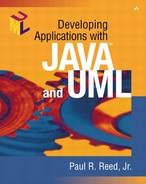Checkpoint
Where We've Been
UML offers four diagrams to model the dynamic view of the application domain.
The interaction diagrams—sequence and collaboration—are used primarily to model the objects as they interact to satisfy the pathway of a given use-case.
Sequence diagrams have a longer history than collaboration diagrams and are typically preferred over collaboration diagrams. The two relay the same message, but in different formats. Of all of the UML dynamic diagrams, the sequence diagram is the most heavily used.
The state diagram models the lifecycle of one class. State diagrams appear most often in applications that have a real-time element (e.g., an embedded system). Often control and boundary classes might contain interesting state information that can be described in further detail through state diagrams.
An activity diagram models complex workflows, operations, or algorithms. Activity diagrams closely follow flowchart notation and can be used to model the pathways through a use-case.
Usage matrices allow a dynamic view of the application as it deals with loadings from both a network and a database perspective.
Where We're Going Next
In the next chapter we:
Explore the technology landscape as it pertains to projects being implemented today with Java as the solution set.
Review the differences between logical and physical tiers and how an application can plan ahead to eventually take advantage of a multitier solution.
Review the different mechanisms by which tiers can communicate.
Explore issues concerning the management of transaction scope with and without a coordinator such as Enterprise JavaBeans.
Examine how to leverage the Internet to migrate portions of Remulak Productions' application to the Web.
